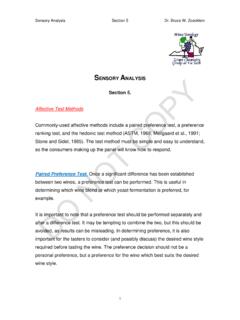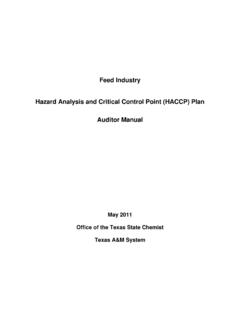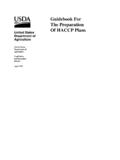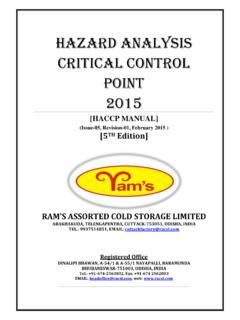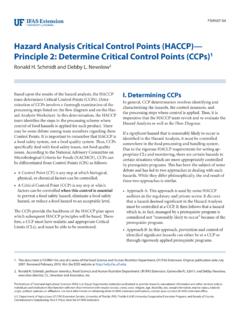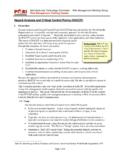Transcription of HAZARD ANALYSIS AND CRITICAL CONTROL P (HACCP)
1 HAZARD ANALYSIS AND CRITICAL CONTROL POINTS (HACCP) Learning Outcomes. The student will understand that HACCP planning helps one understand the complex relationships among the kaleidoscope of grape growing and winemaking variables. One of the problems with relying too heavily simply upon empirical observation is that if two outcomes are similar, we have a tendency to assume they must have a similar cause. This may or may not be correct. The importance of the core principle of HACCP goes back to Francis Bacon, who reminded us, Genius is like fleet of foot, method is the right path. Fleetness of foot on the wrong path never leads to knowledge. Chapter Outline Viticultural HACCP-Like Plans CCP: Vineyard Management Practices Winery HACCP-Like Plans Bottling HACCP-Like Plans Section 1.
2 HACCP is a proactive management system that can be utilized by winemakers and grape growers to help assure product quality CONTROL from the vineyard to the glass, through the identification and monitoring of the CRITICAL CONTROL Points during each production step. The HACCP (pronounced HASS-sip) concept was originally developed by NASA and the Pillsbury Company in the 1960s to meet the needs for food safety in the space program (Untermann et al., 1996). HACCP Section 1 Dr. Bruce W. Zoecklein 2 HACCP-like plans are developed to fit the wine industry s need to integrate chemical, physical, microbiological, and sensorial analyses into quality and stylistic CONTROL programs. Such plans are designed to identify where CRITICAL CONTROL Points (junctures in processing, crucial to quality and stylistic success) occur, and establish monitoring and verification measures to ensure compliance with standard operating procedures.
3 Typical HACCP plans include seven steps: 1. Creating a processing flow diagram from vine to bottle, and beyond. 2. Identifying the CRITICAL CONTROL points (CCPs) at each step in the process. 3. Establishing CRITICAL limits (CLs) for each ANALYSIS to be conducted. 4. Developing a monitoring procedure for each CCP. 5. Establishing a plan for corrective action when CCPs are not met. 6. Establishing a record system to document corrective steps taken. 7. Developing a verification plan for all analyses. Wine industry HACCP-like plans begin with establishing a processing flowchart or diagram that starts in the vineyard and ends with movement of wine through the distribution network to the consumer. At each step, CCPs are identified and ranked in terms of their importance, and a corresponding list of analytical CONTROL measures is established.
4 Properly prepared, such HACCP plans help answer several basic questions: When are specific analyses needed during the process? Why are they important, and where does each fit into the winemaker s processing protocol? How are analytical results interpreted, and what is the expected range of values for each? What corrective measures are needed if results do not fall within specifications? HACCP Section 1 Dr. Bruce W. Zoecklein 3 Each CCP is examined and evaluated using chemical, physical, microbiological and/or sensorial methods. Results are assessed at specific time intervals to determine if additional steps or corrective steps are required. HACCP allows growers and winemakers to customize a quality management system tailored entirely to specific needs and to production practices and philosophy.
5 The following examples address typical vineyard and winery production concerns in the context of a HAACP-like program. Viticultural HACCP-Like Plans Viticultural HACCP plans can be written in general, or can be created to focus on specific grape growing or winemaking issues. Properly conceived and developed, a viticultural HACCP-like plan can help link vineyard management to wine quality, and answer the following questions: Are there agreed-upon written product and handling specifications between the vineyard and winery? Has the person responsible for spraying completed a farm chemical user training course? Can you prove that only approved chemicals are used, and that they are applied correctly? Are you certain that grape safety and quality aren t compromised during transport to the winery?
6 Can your grapes be traced from the winery back to a particular block in your vineyard? Can you provide records of all operations on your farm that affect the safety and quality of your grapes? Are staff members who do CRITICAL jobs trained properly? HACCP Section 1 Dr. Bruce W. Zoecklein 4 Viticultural HACCP plans are used to determine CCPs, establish limits for each, develop a monitoring system, plan for corrective action, and record and verify assessments. Examples of viticultural CCPs include the following: vine balance shoot density crop to pruning-weight ratio canopy microclimate fruit exposure training and trellising system vineyard uniformity Variability between berries, clusters, and vines may impact wine quality. If ten berries develop at different rates, each will reach optimum quality potential at a slightly different time.
7 Since the overall quality of the juice is simply the average of all ten berries, asynchronous berry development may result in a reduction in overall quality. A CCP may be the degree of uniform vegetative growth and fruit development that can be influenced by pruning, the degree of shoot uniformity, irrigation, etc. HACCP planning helps to define acceptable uniformity. It also helps determine sources of variation and can be used to create a management strategy for variation. Although variation between berries is poorly understood, it has a large potential impact on grape and wine quality. Variables include berry size, composition, seed number and size, and berry position. The importance of these issues is seen in vine-to-vine variability in a uniform vineyard as a percentage of coefficient of variation: Brix 4-5% pH 3-4 % HACCP Section 1 Dr.
8 Bruce W. Zoecklein 5 TA 10-12% berry weight 6-20% color 13-18% Additional viticultural CCPs include the following: soil and plant ANALYSIS soil moisture canopy density day/night temperatures rainfall wind speed and direction average time between bloom and harvest cane number pruning weights number of buds cane weights (pruning weight per cane number) clusters per vine clusters per shoot shoots per meter of row cluster weight per vine yield per vine (cluster number x cluster weight) average cluster weight (yield per number of clusters) vine balance (yield per unit pruning weight) vigor index (pruning weight per vine spacing) sample method sample size sample processing method HACCP Section 1 Dr. Bruce W. Zoecklein 6 CCP: Vineyard Management Practices It is widely understood that some vineyard spray materials, including elemental sulfur, can impact SLO formation.
9 As such, a separate detailed viticultural HACCP plan should be developed. The nitrogen required by yeast for healthy fermentation is present in two forms: ammoniacal N, and the free alpha-amino acids (FAN) that can be taken up and used by the cell. Together, these two sources contribute the nitrogen utilized by yeast, referred to as fermentable or yeast-assimilable nitrogen (YAN). There is a correlation between low concentrations of YAN and SLO formation. A number of viticultural and environmental factors can impact YAN and, therefore, could be important CCPs in a HACCP plan. These may include the following: cultivar rot incidence block vineyard mulch crop load moisture stress maturity spray residues Certain vineyard blocks consistently produce higher levels of sulfur-like off odors.
10 Therefore, a specific block may be a CCP. Block differences may be due, in part, to relative changes in quantity and/or relative proportions of YAN components (FAN versus ammonia, and specific FAN concentrations). Such blocks or sub-blocks should be segregated and treated differently. Vineyard factors such as yield, maturity, and incidence of fruit rot can each impact YAN and, therefore, may be CCPs in a HACCP plan. HACCP Section 1 Dr. Bruce W. Zoecklein 7 Winery HACCP-Like Plans The following is an example of a HACCP-like plan for the management of sulfur-like off odors (SLO) in wine. Such a plan would be designed to identify and understand viticultural and winemaking practices that may impact the production of these compounds, and how they may be managed.

